#roman archeology
Explore tagged Tumblr posts
Text

Science Services’ Science Program series booklet Roman Archeology. Nelson Doubleday - 1967.
#vintage illustration#vintage books#science books#children’s books#educational books#learning aids#science#vintage children’s books#learning#educational aids#the sciences#archeology#the romans#roman archeology
4 notes
·
View notes
Text


adam and eve apple. quote translates to “I am your half”
#arqueologia#archaeologylovers#ancientcivilization#museum#art#history#photography#archaeological#antiquities#arte#archaeologylife#archeology#ancient#archaeologist#archaeology#antiquity#artifacts#archeologie#historical#culture#sculpture#artlovers#ancientruins#roman#ologie#mythology#photooftheday#archeotravel#arch#archeologicalsite
7K notes
·
View notes
Text

Roman sea life mosaic from the House of the Faun in Pompeii, dating back to the 2nd century BC. Displayed in the Archeological Museum of Naples, Italy.
#2nd century b.c.#2nd century#mosaic#history#pompeii#roman empire#archeology#sea life#fish#artwork#art#marine life
2K notes
·
View notes
Text
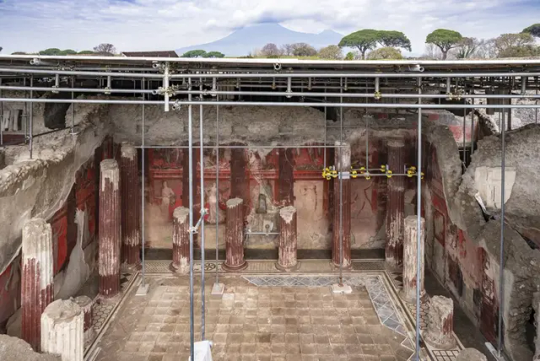
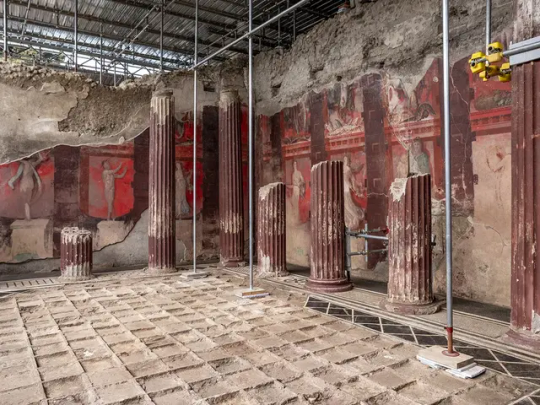
Stunning Frescoes of a Mysterious Dionysian Cult Discovered in Ancient Pompeii
Created more than a century before the eruption of Mount Vesuvius in 79 C.E., the wall paintings provide rare insights into secret rituals conducted in the Roman city.
Archaeologists in Pompeii have uncovered a series of nearly life-size frescoes spanning three walls of an ancient banquet hall. Set against a ruby-red backdrop, the wall paintings depict female followers of Dionysus—the Greek god of wine and ecstasy—engaged in secretive cult rituals.

Also known as maenads or bacchantes, the women have swords in their hands and slaughtered animals draped across their bare shoulders. Alongside flute-piping satyrs, they’re engaged in a wild, ritualistic dance, while shellfish, eels, squid and poultry dangle above them. In the center of it all, a clothed woman awaits her initiation into the cult.
Pompeii is full of colorful frescoes, but this one is particularly rare. The only other large wall painting depicting a Dionysian ceremony was unearthed in the so-called Villa of the Mysteries in the ancient city’s suburbs in 1909, according to a statement from the Pompeii Archaeological Park.
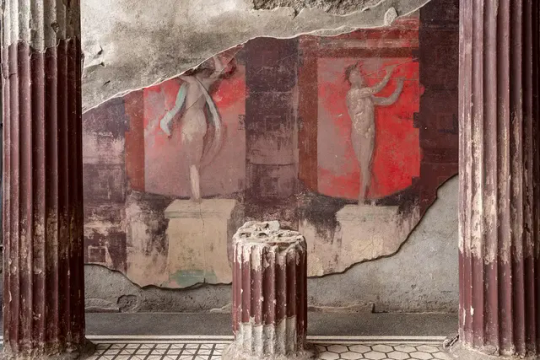
Known as a megalography—a Greek term for a large-scale painting—the banquet hall fresco was uncovered at the newly excavated House of Thiasus. It dates to the first century B.C.E., more than 100 years before Mount Vesuvius erupted in 79 C.E. and cast pumice and ash down upon Pompeii.
“In 100 years’ time, today will be remembered as historic,” Alessandro Giuli, the Italian culture minister, told reporters at the unveiling of the wall paintings on Wednesday, per Reuters’ Crispian Balmer. “Alongside the Villa of the Mysteries, this fresco forms an unparalleled testament to the lesser-known aspects of ancient Mediterranean life.”
As Giuli suggests, the festivals depicted in the frescoes were thoroughly secretive, even in antiquity.
“These were mystery cults, so what they did remains a mystery, even in the ancient written sources,” Sophie Hay, an archaeologist at Pompeii, tells the London Times’ Philip Willan.

Even so, the frescoes at Pompeii offer valuable insights into what worship of Dionysus, also known as the Roman god Bacchus, entailed.
Wine, of course, was central to these festivities. But researchers think cult members may have also consumed other substances, like opium, to enter “trance-like states,” Live Science’s Kristina Killgrove writes.
The women in the fresco are both hunters and dancers, suggesting that the duality of slaughter and revelry was a central tenet. The clothed, mortal woman who is awaiting initiation is depicted as “oscillating between these two extremes, two forms of the female being at the time,” Gabriel Zuchtriegel, director of the archaeological park, says in the statement.

“For the ancients, the bacchante or maenad expressed the wild, untameable side of women; the woman who abandons her children, the house and the city, who breaks free from male order to dance freely, go hunting and eat raw meat in the mountains and the woods,” he adds. In contrast, Zuchtriegel explains, were the women who emulated the goddess Venus and lived by the dictates of Roman society.
“The question is, what do you want to be in life, the hunter or the prey?” Zuchtriegel told reporters at the unveiling.
The hunting scenes may also stand as analogues for life and death. In the House of Thiasus, one woman eats raw meat. At the Villa of Mysteries, one breastfeeds a young goat.
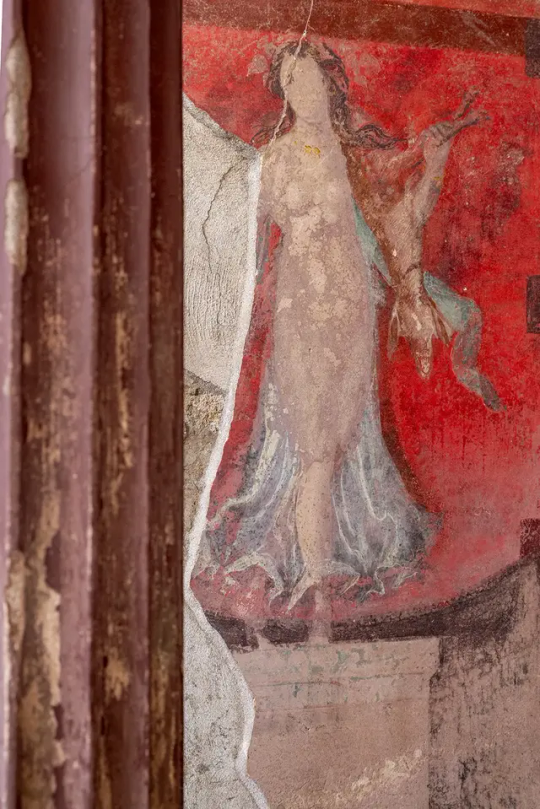
“It’s the double function of death and rebirth. Dionysus dies and is reborn. Through initiation into the cult, you are born again,” Zuchtriegel says to the London Times.
By 186 B.C.E., these festivals were at risk of dying out, as Roman authorities attempted to crack down on the scandalous ceremonies. But the presence of the paintings in the House of Thiasus and the Villa of Mysteries suggest that the secret rituals survived.
Although archaeological work continues, the frescoes are now on public display.
By Eli Wizevich.
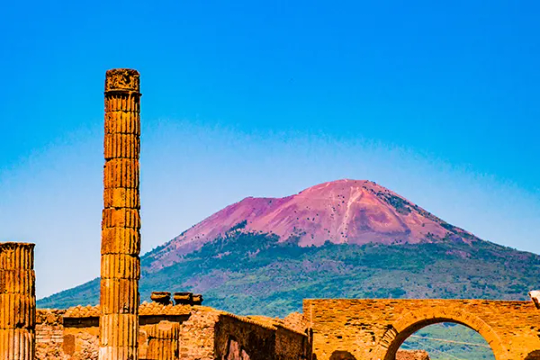

#Pompeii#Stunning Frescoes of a Mysterious Dionysian Cult Discovered in Ancient Pompeii#Mount Vesuvius#frescoes#ancient artifacts#archeology#history#history news#ancient history#ancient culture#ancient civilizations#roman history#roman empire#roman art#ancient art
1K notes
·
View notes
Text

~ Helmet of Gladiator.
Date: A.D. 1st century
Medium: Bronze
#ancient#ancient art#history#museum#archeology#ancient history#archaeology#roman#ancient roman#ancient rome#Gladiator#armor#helmet#bronze#1st century
2K notes
·
View notes
Text

A Roman Gold Snake Armlet,
Circa 1st Century B.C.-1st Century A.D.
4 3/8 in. (11.3 cm.) wide.
Courtesy: Christies
#art#history#design#style#archeology#sculpture#antiquity#collectors#christie's#snake#bracelet#roman#gold#armlet#1st century#happy new year#lunar new year
1K notes
·
View notes
Text
Roman-era silver 'toilet spoon' discovered in Wales

A Roman-era silver "toilet spoon" discovered by a metal detectorist in the U.K. has been declared a "treasure" by experts.
Valentinas Avdejevas made the peculiar finding in 2020 while exploring Vale of Glamorgan, a county in Wales. He surrendered the metal artifact to the Portable Antiquities Scheme for Wales, a local authority that works directly with metal detectorists who have unearthed artifacts. The utensil is currently in the possession of Amgueddfa Cymru – Museum Wales, according to a statement.
The narrow silver spoon (also known as a Roman ligula) contains a shallow, circular bowl attached to a thin, bent handle and would have been used to scoop out cosmetics and perfume from long-necked bottles. Read more.
3K notes
·
View notes
Text




Streets of Pompeii.
March 2024
#pompeii#pompei#pompei scavi#campagna#italia#italy#travel#original photography#photographers on tumblr#photography#lensblr#historical architecture#architecture#archaeology#archeology#antiquity#ancient history#wandering#urbanexploration#urban exploration#ancient rome#ancient roman#roman architecture#ancient architecture#wanderingjana
442 notes
·
View notes
Text
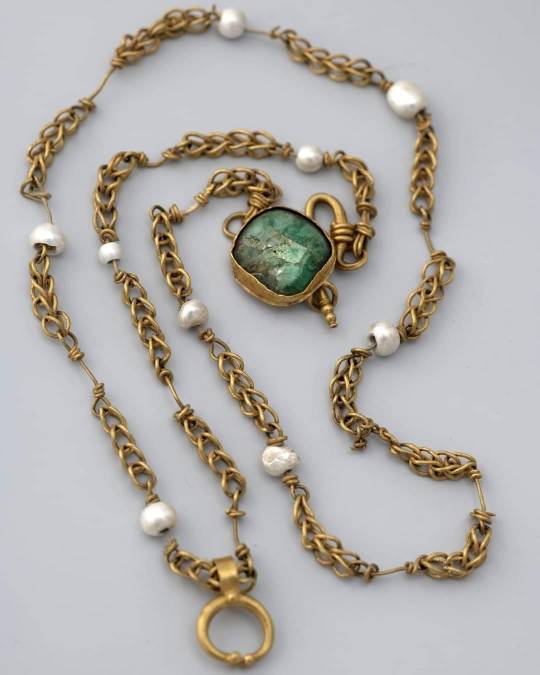
Necklace of gold, emerald and pearls, from the House of Julia Felix in Pompeii. Exhibition "Pompeii, Journey to Beauty", Musei nazionali di Matera - Sede Ridola, Italy. Photography by Antonio Esposito Marroccella
945 notes
·
View notes
Text
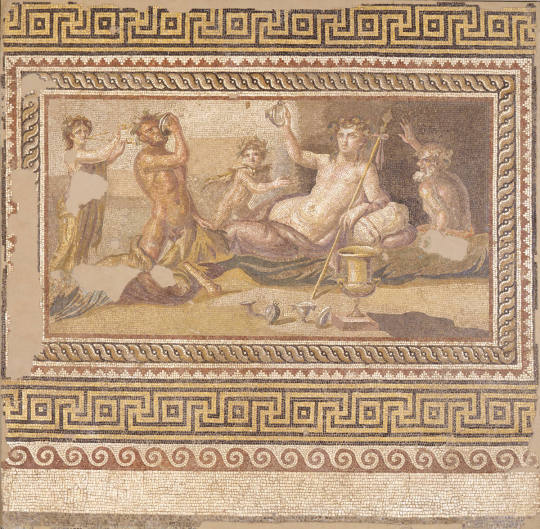
Heracles and Dionysus Drinking contest (Early 2nd AD century, Antioch, Imperial Roman mosaic)
This mosaic from an Atrium House in Antioch depicts a funny small story known in classical art as a drinking contest between Heracles (Hercules) and Dionysus (Bacchus). According to the story, Heracles challenges Dionysus in a drinking contest and of course loses. The result of their contest seems to be an anecdotal story that he joins his Thiasus for a short while.
In this mosaic we can spot Heracles naked and kneeling while chugging down from his cup (the lion mane and club resting before his knees). To the far left we can detect the figure of a double-flute playing menad while we see Dionysus casually resting upon pillows, holding a thyrsus/spear to his hand and showing his own empty cup to Heracles while being surrounded by the satyr Silenus (far right) and his cup-bearer, the little satyriscus to the center. One can also detect the golden-colored crater in the middle.
The parallels between the two figures seem to be incredible:
Both are sons of Zeus and both are arguably the youngest of their classes (Dionysus is the youngest god of the Olympians born by Zeus and Heracles according to some roman sources is the last demi-god from the last mortal lover Zeus takes)
Both are born by a mortal woman (Alcmene and Semele respectably)
Both have been induced in madness by Hera (Dionysus repeatedly while Heracles was turned mad and threw his children with Megara in the fire), and continusly targeted by the wrath of the goddess
Both become divine just in different ways (Dionysus is established as one of the 12 gods of Olympus while Heracles becomes a god post-mortem)
Both seem associated with Elysian mysteries
Both are associated one way or another with theater or role-playing (Dionysus being the god of theater among others while Heracles had at some point dress as a woman while living with Omphale)
One is associated with strength and power (Heracles) while the other is associated with art but also Madness (Dionysus)
Both are associated with the youth (Heracles for his war achievements while Dionysus is also portrayed as a youth many times)
Dionysus according to some myths is married to a god-made woman (Ariadne) while god-made Heracles marries a goddess (Hebe)
Both figures travel to the underworld (Heracles during his 12 labors when he goes to take Cerberus while Dionysus according to orphic traditions as Zagreus descends to the underworld to come back out as Dionysus through Semele)
Consequently to above, both figures suffered a painful death (Dionysus as Zagreus being torn to pieces and/or eaten by Titans, Heracles poisoned by Hydra's poison in Nessus's blood through his marital chiton and consequently burnt)
Both figures have been iconically depicted in association with a wild animal (Heracles wearing a lion skin, Dionysus either riding or wearing a leopard)
Both figures have myths that associate them with non-human creatures (Heracles having good time with the Centaurs, Dionysus being followed by Satyrs)
I find it interesting how we do not have more art or talk about these two iconic mythological figures!
#greek mythology#tagamemnon#heracles#hercules#dionysus#dionysos#bacchus#greek gods#ancient greek gods#ancient roman#archeology#mosaics#roman mosaics#hebe#ariadne#dionysus and ariadne#heracles and hebe#classical greek art#heracles and dionysus#hera#zeus#alcmene#semele#megara#ancient greek art#ancient greece
213 notes
·
View notes
Text

Roman street - Timgad, 2022
#original photographers#photographers on tumblr#travel#algeria#algerie#roman ruins#archeology#street photography#streetphoto color#ancient rome#street
180 notes
·
View notes
Text

Roman Agora Gate, Athens ♥
#greece#ruins#ancient ruins#roman ruins#archaeology#archeology#architecture#greek temple#roman agora#hellas#ancient history#travel#europe#wanderlust#gate#places#hellenistic#ancient greece
132 notes
·
View notes
Text

Arc d'Orange, Ier siècle apr. J.-C., Provence-Alpes-Côte d'Azur, France
#Arcus#Fornix#Porta#Antiquity#classical antiquity#Rome#ancient rome#Roman Empire#Arausio#archeology#architecture#art#art history#history#Europe#France#Provence Alpes Côte d'Azure
143 notes
·
View notes
Text
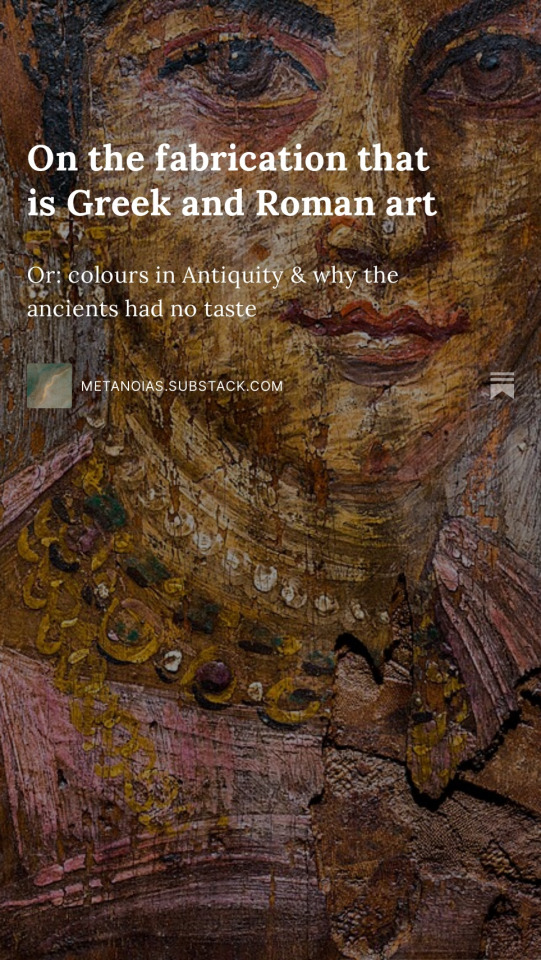
When you think of ancient Greece or the Roman Empire, visions of white togas, ivory temples and sand-coloured amphitheatres likely come to mind.
If so, you might be in for a surprise.
Because this off-white and eggshell-dominated palette, which inspired the pristine surfaces of Renaissance sculptures and the blank facades of Neoclassical buildings, is… a lie.
We now know the ancient world was steeped in colour. It was, perhaps, a tad too colourful for our modern sensibilities — even borderline garish at times.
Click here to learn why generations of scholars and artists believed in a monochrome Classical Antiquity and see historically accurate reconstructions of ancient statues and buildings in all their glorious peacockery.
#art#ancient art#ancient greece#ancient rome#ancient history#ancientmonuments#ancient cities#ancient civilizations#ancient sculpture#roman empire#roman art#art history#history#archeology#archaeology#colors#colours#colour#italy#greece#greek mythology#roman mythology#ancient greek#rome#rome italy#histoire#historic
747 notes
·
View notes
Text

A Roman marble head of a Celtic hound Circa 2nd Century A.D.
#A Roman marble head of a Celtic hound#Circa 2nd Century A.D.#marble#roman marble statue#roman marble sculpture#ancient artifacts#archeology#history#history news#ancient history#ancient culture#ancient civilizations#ancient rome#roman history#roman empire#roman art#ancient art
1K notes
·
View notes
Text




~ Oracle statue of Aphrodite Arsinoe II.
Period: Hadrian; Greco-Roman Period
Place of origin: Egypt
Medium: Dolomite
#ancient#ancient art#history#museum#archeology#ancient egypt#ancient sculpture#ancient history#roman#archaeology#egypt#egyptology#Egyptian#ancient roman#oracle#aphrodite#Aphrodite Arsinoe II#hadrian#Greco-Roman#dolomite
1K notes
·
View notes